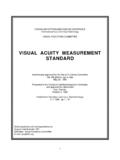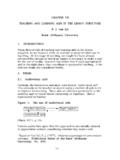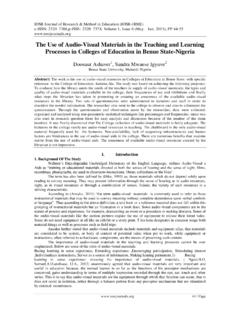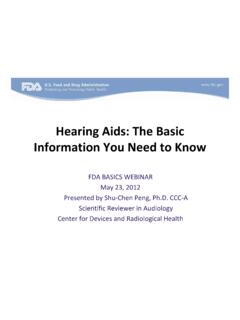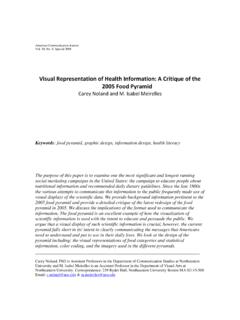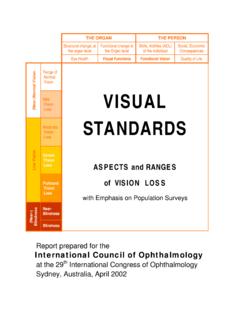Transcription of National Standards for Visual Art& Link To State Dept of Ed
1 Additional Resource for NACD Poster Contest 8-07 Page 1 of 7 National Standards for Visual Art The National Standards for Arts Education Developed by the Consortium of National Arts Education Associations (under the guidance of the National Committee for Standards in the Arts), the National Standards for Arts Education is a document which outlines basic arts learning outcomes integral to the comprehensive K-12 education of every American student. The Consortium published the National Standards in 1994 through a grant administered by MENC, the National Association for Music Education. Visit your State Department of Education for your State Standards on Visual Art State Contacts and Information Find your State department of education, State contacts and organizations at the link below Visual ARTS (K-4) Source: These Standards provide a framework for helping students learn the characteristics of the Visual arts by using a wide range of subject matter, symbols, meaningful images, and Visual expressions, to reflect their ideas, feelings, and emotions; and to evaluate the merits of their efforts.
2 The Standards address these objectives in ways that promote acquisition of and fluency in new ways of thinking, working, communicating, reasoning, and investigating. They emphasize student acquisition of the most important and enduring ideas, concepts, issues, dilemmas, and knowledge offered by the Visual arts. They develop new techniques, approaches, and habits for applying knowledge and skills in the Visual arts to the world beyond school. The Visual arts are extremely rich. They range from drawing, painting, sculpture, and design, to architecture, film, video, and folk arts. They involve a wide variety of tools, techniques, and processes. The Standards are structured to recognize that many elements from this broad array can be used to accomplish specific educational objectives.
3 For example, drawing can be used as the basis for creative activity, historical and cultural investigation, or analysis, as can any other fields within the Visual arts. The Standards present educational goals. It is the responsibility of practitioners to choose appropriately from this rich array of content and processes to fulfill these goals in specific circumstances and to develop the curriculum. To meet the Standards , students must learn vocabularies and concepts associated with various types of work in the Visual arts and must exhibit their competence at various levels in Visual , oral, and written form. In Kindergarten-Grade 4, young children experiment enthusiastically with art materials and investigate the ideas presented to them through Visual arts instruction.
4 They exhibit a sense of joy and excitement as they make and share their artwork with others. Creation is at the heart of this instruction. Students learn to work with various tools, processes, and media. They learn to coordinate their hands and minds in explorations of the Visual world. They learn to make choices that enhance communication of their ideas. Their natural inquisitiveness is promoted, and they learn the value of perseverance. As they move from kindergarten through the early grades, students develop skills of observation, and they learn to examine the objects and events of their lives. At the same time, they grow in their ability to describe, interpret, evaluate, and respond to work in the Visual arts.
5 Through examination of their own work and that of other people, times, and places, students learn to unravel the essence of artwork and to Additional Resource for NACD Poster Contest 8-07 Page 2 of 7 appraise its purpose and value. Through these efforts, students begin to understand the meaning and impact of the Visual world in which they live. Content Standard #1: Understanding and applying media, techniques, and processes Achievement Standard: Students know the differences between materials, techniques, and processes Students describe how different materials, techniques, and processes cause different responses Students use different media, techniques, and processes to communicate ideas, experiences, and stories Students use art materials and tools in a safe and responsible manner Content Standard #2: Using knowledge of structures and functions Achievement Standard.
6 Students know the differences among Visual characteristics and purposes of art in order to convey ideas Students describe how different expressive features and organizational principles cause different responses Students use Visual structures and functions of art to communicate ideas Content Standard #3: Choosing and evaluating a range of subject matter, symbols, and ideas Achievement Standard: Students explore and understand prospective content for works of art Students select and use subject matter, symbols, and ideas to communicate meaning Content Standard #4: Understanding the Visual arts in relation to history and cultures Achievement Standard: Students know that the Visual arts have both a history and specific relationships to various cultures Students identify specific works of art as belonging to particular cultures, times, and places Students demonstrate how history, culture, and the Visual arts can influence each other in making and studying works of art Content Standard #5: Reflecting upon and assessing the characteristics and merits of their work and the work of others Achievement Standard.
7 Students understand there are various purposes for creating works of Visual art Students describe how people's experiences influence the development of specific artworks Students understand there are different responses to specific artworks Content Standard #6: Making connections between Visual arts and other disciplines Achievement Standard: Students understand and use similarities and differences between characteristics of the Visual arts and other arts disciplines Students identify connections between the Visual arts and other disciplines in the Additional Resource for NACD Poster Contest 8-07 Page 3 of 7 curriculum Visual ARTS (5-8) Source: #04 Students in grades 5-8 continue to need a framework that aids them in learning the characteristics of the Visual arts by using a wide range of subject matter, symbols, meaningful images, and Visual expressions.
8 They grow ever more sophisticated in their need to use the Visual arts to reflect their feelings and emotions and in their abilities to evaluate the merits of their efforts. These Standards provide that framework in a way that promotes the students' thinking, working, communicating, reasoning, and investigating skills and provides for their growing familiarity with the ideas, concepts, issues, dilemmas, and knowledge important in the Visual arts. As students gain this knowledge and these skills, they gain in their ability to apply the knowledge and skills in the Visual arts to their widening personal worlds. These Standards present educational goals. It is the responsibility of practitioners to choose among the array of possibilities offered by the Visual arts to accomplish specific educational objectives in specific circumstances.
9 The Visual arts offer the richness of drawing and painting, sculpture, and design; architecture, film, and video; and folk arts -- all of these can be used to help students achieve the Standards . For example, students could create works in the medium of videotape, engage in historical and cultural investigations of the medium, and take part in analyzing works of art produced on videotape. The Visual arts also involve varied tools, techniques, and processes -- all of which can play a role in students' achieving the Standards , as well. To meet the Standards , students must learn vocabularies and concepts associated with various types of work in the Visual arts. As they develop increasing fluency in Visual , oral, and written communication, they must exhibit their greater artistic competence through all of these avenues.
10 In grades 5-8, students' Visual expressions become more individualistic and imaginative. The problem-solving activities inherent in art making help them develop cognitive, affective, and psychomotor skills. They select and transform ideas, discriminate, synthesize and appraise, and they apply these skills to their expanding knowledge of the Visual arts and to their own creative work. Students understand that making and responding to works of Visual art are inextricably interwoven and that perception, analysis, and critical judgment are inherent to both. Their own art making becomes infused with a variety of images and approaches. They learn that preferences of others may differ from their own. Students refine the questions that they ask in response to artworks.
